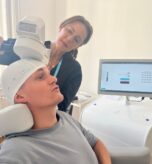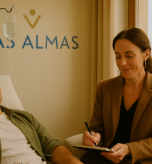The treatment of ADHD at the Las Almas Institute and the Las Almas practices
Introduction
Attention deficit hyperactivity disorder (ADHD) is a neurodevelopmental disorder typically diagnosed in childhood but often persists into adulthood. Epidemiological studies show that approximately 60% of ADHD cases diagnosed in childhood remain symptomatic in adulthood (Faraone et al., 2006). In recent years, scientific understanding of the long-term persistence of the disorder has expanded significantly, leading to increased diagnosis and therapeutic care in adulthood.
Symptomatic manifestation in adulthood
In contrast to childhood ADHD symptoms, which are often manifested by motor hyperactivity, impulsivity, and attention deficits, adults exhibit a different constellation of symptoms. Motor restlessness often fades into the background and is replaced by a subjectively perceived inner tension and restlessness (Kooij et al., 2010). Attention deficits primarily manifest themselves in organizational problems, procrastinatory behavior, and affective instability. These changes can have significant impacts on social, professional, and personal life. The degree of impairment correlates strongly with the individual's level of suffering (Barkley et al., 2008).
Etiology and neurobiological basis
The pathophysiological mechanisms of ADHD are multifactorial and involve both genetic and environmental influences. Genetic studies suggest a heritability of approximately 70–80%, making ADHD one of the most genetically determined psychiatric disorders (Faraone & Larsson, 2019). Polymorphisms in genes involved in the regulation of dopaminergic, noradrenergic, and serotonergic neurotransmission are a focus of research.
From a neurobiological perspective, dysregulation is evident in cortico-striato-thalamo-cortical networks, which are responsible for, among other things, executive functions and emotion regulation (Cortese et al., 2012). Functional imaging studies have demonstrated reduced activity in the prefrontal cortex and basal ganglia, which correlates with deficits in impulse control and attention regulation (Rubia et al., 2014).
Therapeutic approaches for ADHD
Pharmacological interventions
Pharmacological treatment is the first line of treatment for ADHD. Stimulants such as methylphenidate and amphetamines are primarily used, which increase neurotransmitter concentrations in the synaptic cleft by inhibiting the reuptake of dopamine and norepinephrine (Faraone & Biederman, 2005). Non-stimulant medications such as atomoxetine and guanfacine are also available for adults, and are particularly indicated for comorbid anxiety disorders and substance abuse (Spencer et al., 2008).
Neurofeedback therapy: evidence and effectiveness
An increasingly established therapeutic approach in the non-pharmacological treatment of ADHD is Neurofeedback therapyThis therapeutic procedure is based on the real-time imaging of neuronal activity patterns using EEG technology. Patients learn to voluntarily modulate specific brain activity to promote self-regulation of cognitive processes (Arns et al., 2014).
Neurofeedback primarily trains the normalization of the theta/beta ratio in the frontal lobe, which is often dysregulated in ADHD patients. Controlled studies demonstrate significant improvements in attention regulation, impulse control, and executive functions (Arnold et al., 2012). These effects are not only measurable in the short term but also demonstrate long-term stability (Gani et al., 2008).
In the Las Almas Institute Mallorca This form of therapy is used as part of an integrative approach. Neurofeedback sessions are combined with behavioral therapy and mindfulness-based interventions to achieve a sustainable improvement in self-regulation skills.
Psychotherapeutic procedures
In addition to medication and neurofeedback-based interventions, cognitive behavioral therapy (CBT) and mindfulness-based techniques are used. The goal is to identify and modify dysfunctional behavioral patterns and promote adaptive coping strategies (Young et al., 2015). Clinical studies have shown that CBT is particularly effective in reducing procrastination, disorganization, and emotional dysregulation (Safren et al., 2005).
Holistic therapy approach at the Las Almas Institute
The Las Almas Institute Mallorca pursues a holistic therapeutic approach that integrates medication, neurofeedback-based, and psychotherapeutic procedures into a structured treatment plan. Through individualized adaptation of therapy methods, patients are optimally supported in their neurocognitive development.
Multimodal therapy includes:
-
Neurofeedback therapy to promote neuronal self-regulation
-
Cognitive behavioral therapy to change dysfunctional thought patterns
-
Mindfulness-based methods to increase emotional resilience
Conclusion
Evidence-based therapy for ADHD requires an integrative treatment approach that addresses both neurobiological and psychosocial factors. Las Almas Institute Mallorca State-of-the-art therapeutic procedures are combined to achieve sustainable improvements in patients' symptoms and quality of life. The integration of integrative therapy methods enables long-term therapeutic success that has been proven effective and safe in clinical practice.
.







